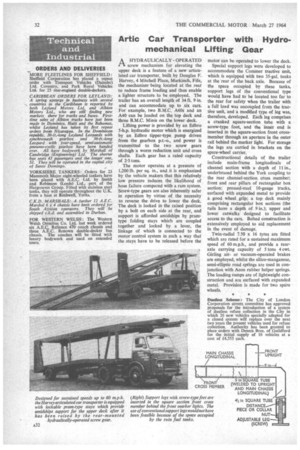Artic Car Transporter with Hydromechanical Lifting Gear
Page 34

If you've noticed an error in this article please click here to report it so we can fix it.
A HYDRAULICALLY OPERATED .1--V screw mechanism for elevating the upper deck is a feature of a new articulated car transporter, built by Douglas F. Harvey, 4 Mitchell Place, Markinch, Fife, the mechanism being located at the rear to reduce frame loading and thus enable a lighter structure to be employed. The trailer has an overall length of 34 ft. 9 in. and can accommodate up to six cars. For example, two B.M.C. A60s and an A40 can be loaded on the top deck and three B.M.C. Minis on the lower deck.
Lifting power is provided by an Edbro 5-13.p. hydraulic motor which is energized by an Edbro tipper-type pump driven from the gearbox p.t.-o., and power is transmitted to the two screw gears through a worm reduction unit and cross shafts. Each gear has a rated capacity of 2.5 tons.
The motor operates at a pressure of 1,200 lb. per sq. in., and it is emphasized by the vehicle makers that this relatively low pressure reduces the likelihood of hose failure compared with a ram system. Screw-type gears are also inherently safer in operation by virtue of the necessity to reverse the drive to lower the deck. The deck is locked in the raised position by a bolt on each side at the rear, and support is afforded amidships by pramtype folding stays which are coupled together and locked by a lever, the linkage of which is connected to the motor control system in such a way that the .stays have to be released before the
motor can be operated to lower the deck.
Special support legs were developed to accommodate the Commer tractive unit, which is equipped with two 35-gal tanks at the rear of the back axle. Because of the space occupied by these tanks, support legs of the conventional type would have had to be located too far to the rear for safety when the trailer with a full load was uncoupled from the tractive unit, and a modified type of leg was, therefore, developed. Each leg comprises a cranked square-section tube with a screw-type foot, and the inner end is inserted in the square-section front crossmember through an aperture in the outer rail behind the marker light. For storage the legs are carried in brackets on the spare-wheel carrier.
Constructional details Of the trailer include main-frame longitudinals of channel section with a depth of 11 in., underbraced behind the York coupling to the rear channel-section cross member; front and rear pillars of rectangular box section; pressed-steel 10-gauge tracks, surfaced with expanded metal to provide a good wheel grip; a top deck mainly comprising rectangular box sections (the rails have a depth of 9 in.); upper and lower catwalks designed to facilitate access to the cars. Bolted construction is extensively employed to aid replacement in the event of damage.
Twin-radial 7,50 x 16 tyres are fitted which are rated for a sustained maximum speed of 60 m.p.h., and provide a rearaxle carrying capacity of 5 tons 4 cwt. Girling airor vacuum-operated brakes are employed, whilst the silico-manganese, semi-elliptic road springs are used in conjunction with Aeon rubber helper springs. The loading ramps are of lightweight construction and are surfaced with expanded metal. Provision is made for two spare wheels.
Dustless Scheme: The City of London Corporation streets committee has approved proposals for the introduction of a system of dustless refuse collection in the City in which 20 new vehicles specially adapted for a closed system will replace over the next two years the present vehicles used for refuse collection. Authority has been granted to place orders with Dennis Bros. of Guildford for the initial supply of 10 vehicles at a
cost of £4,555 each.




































































































